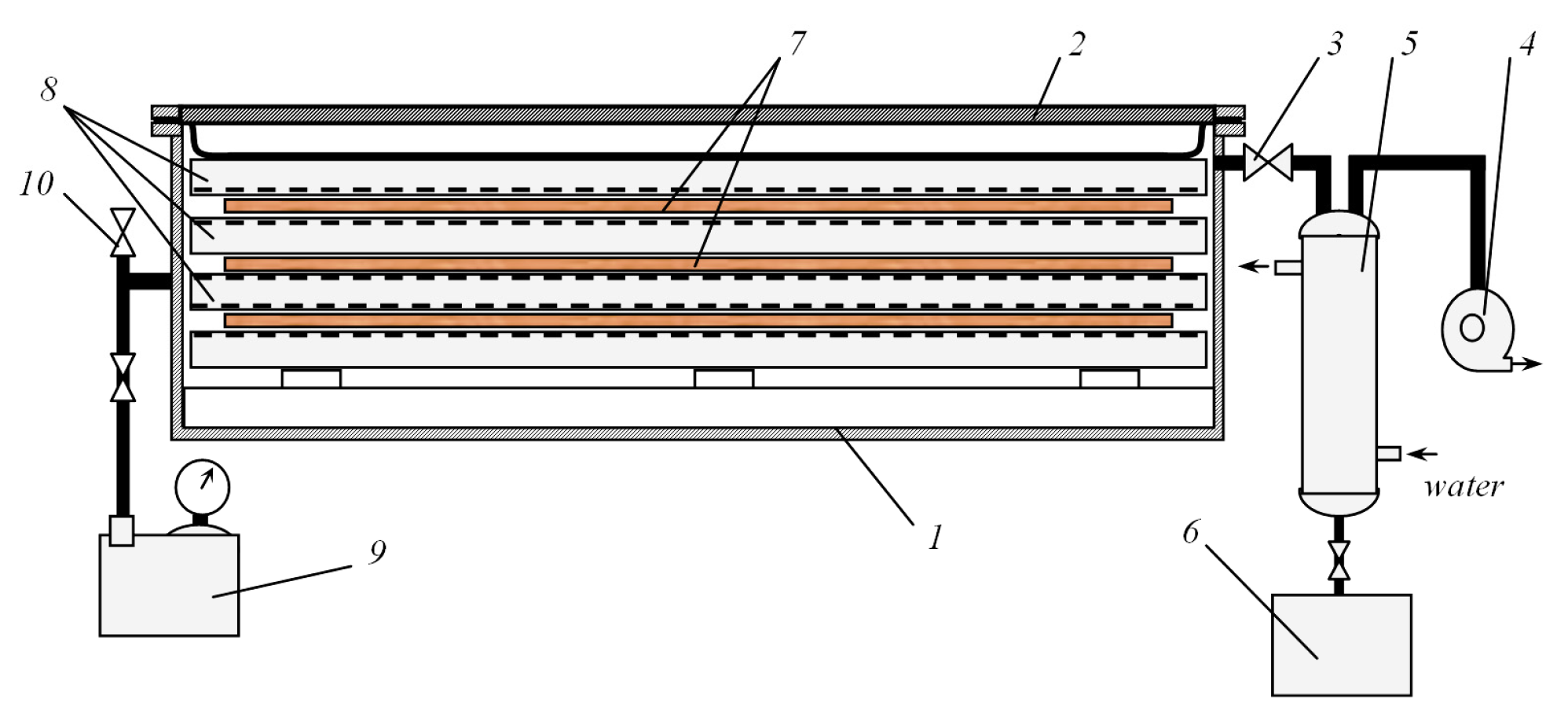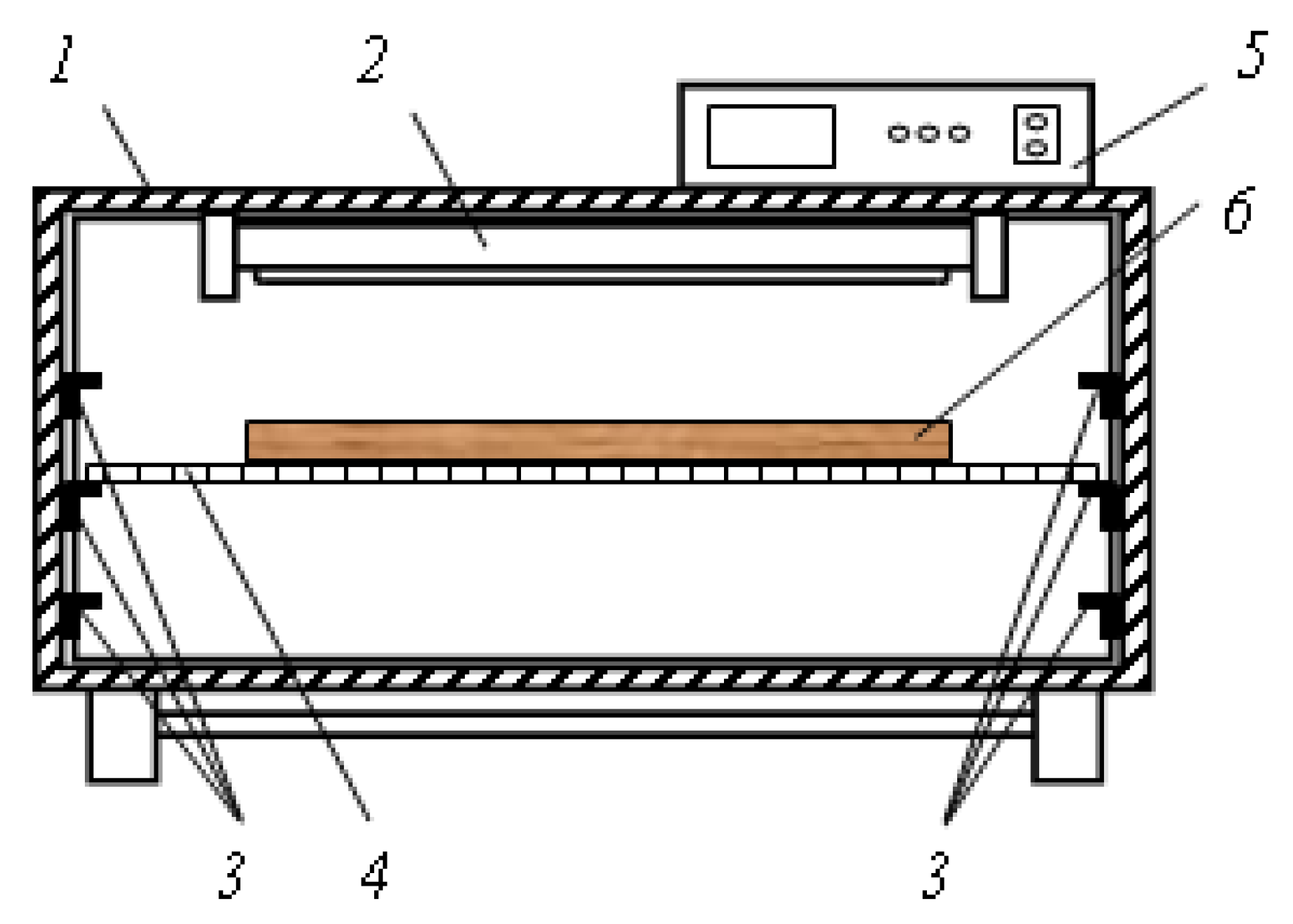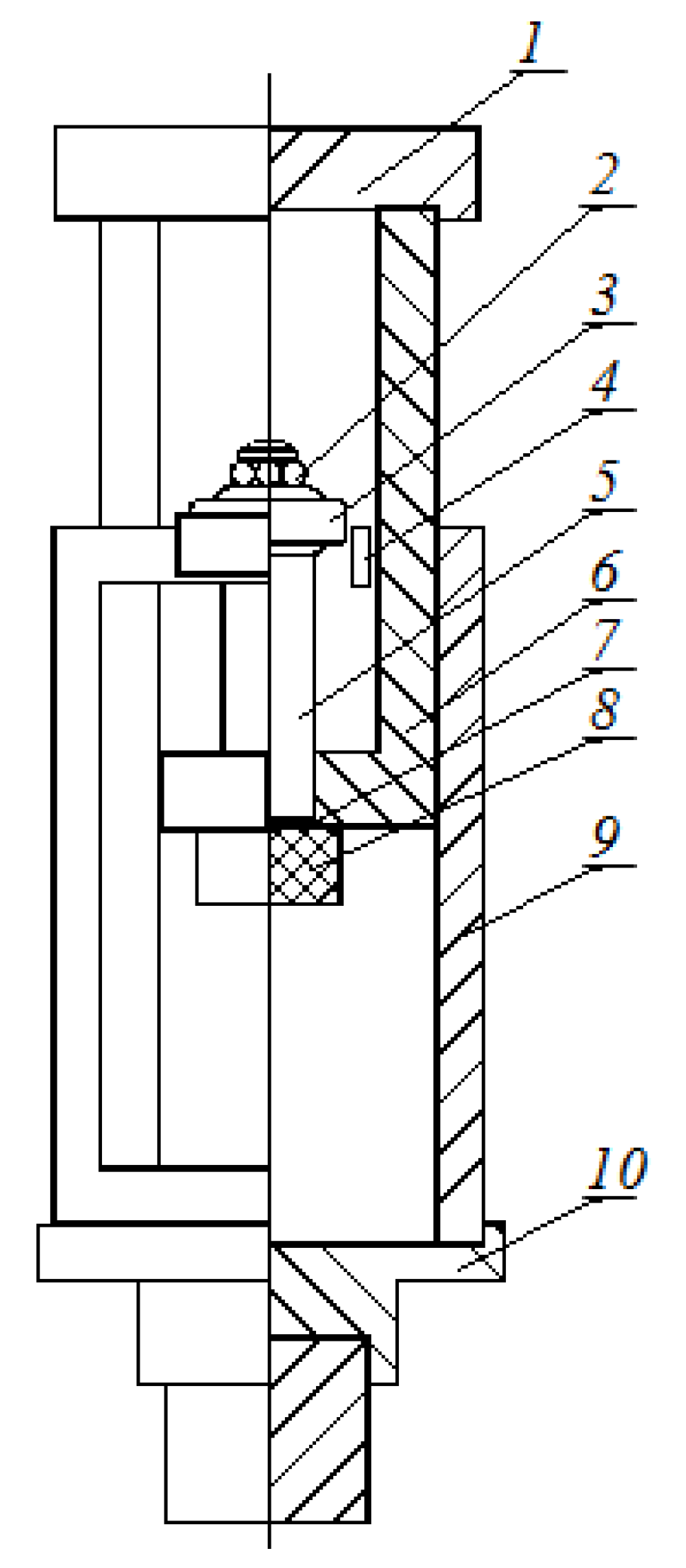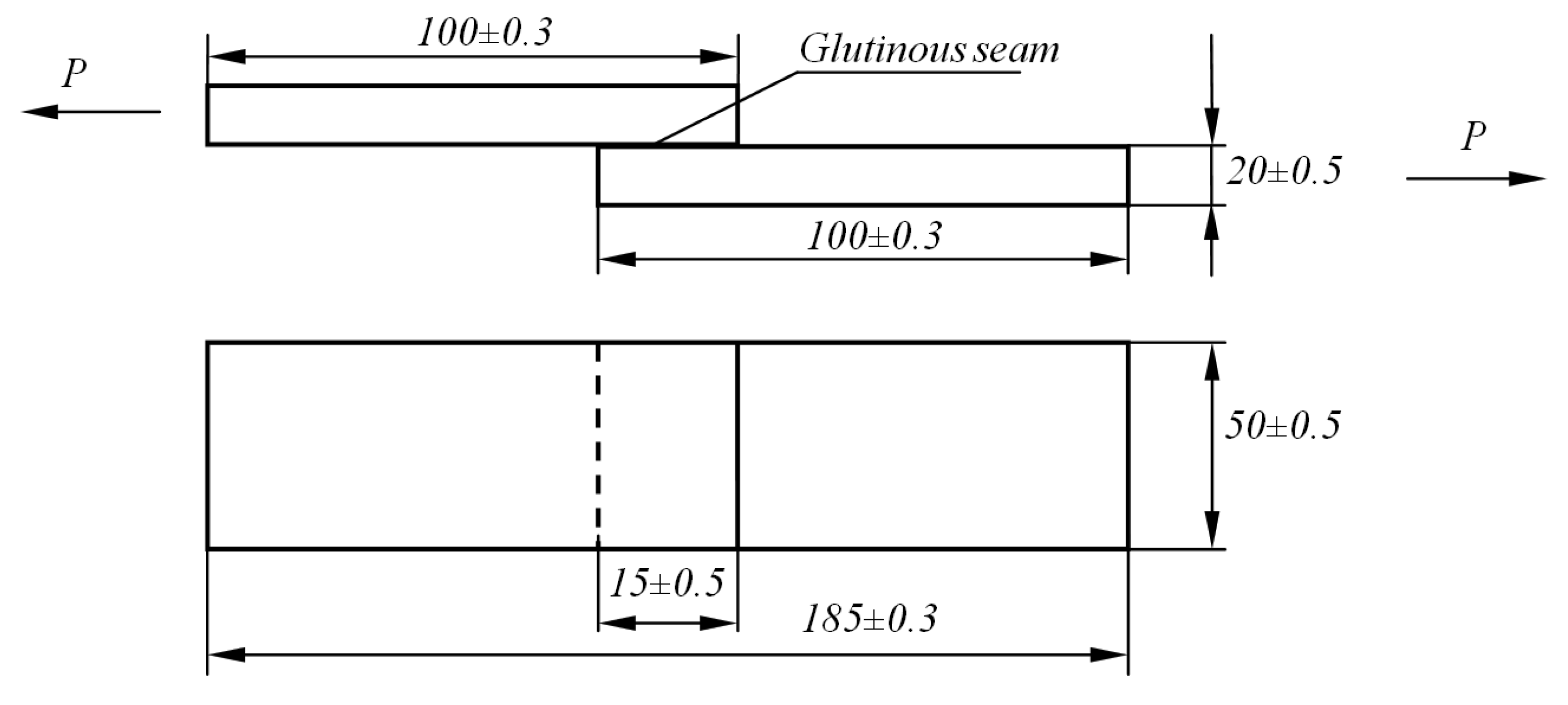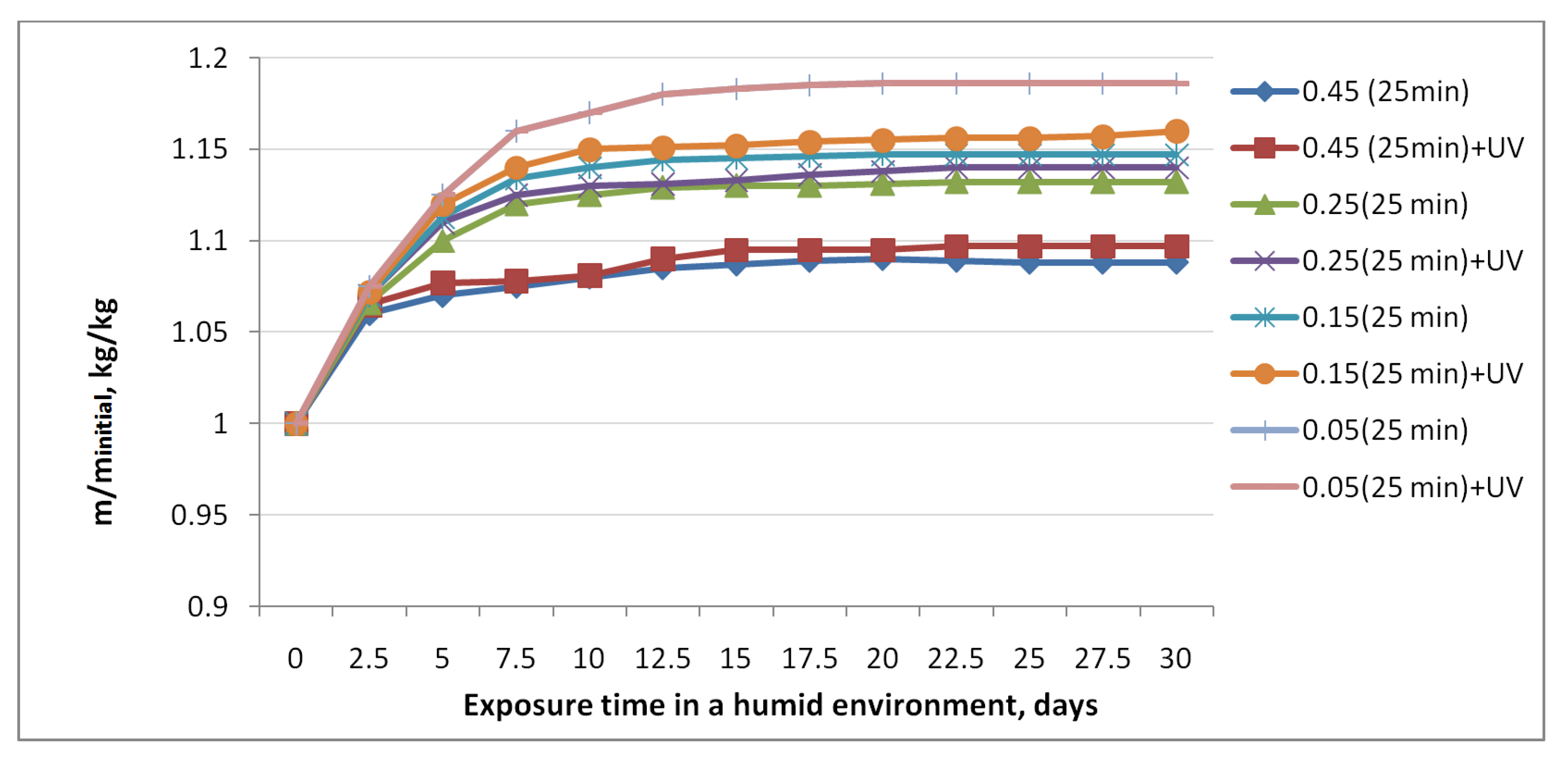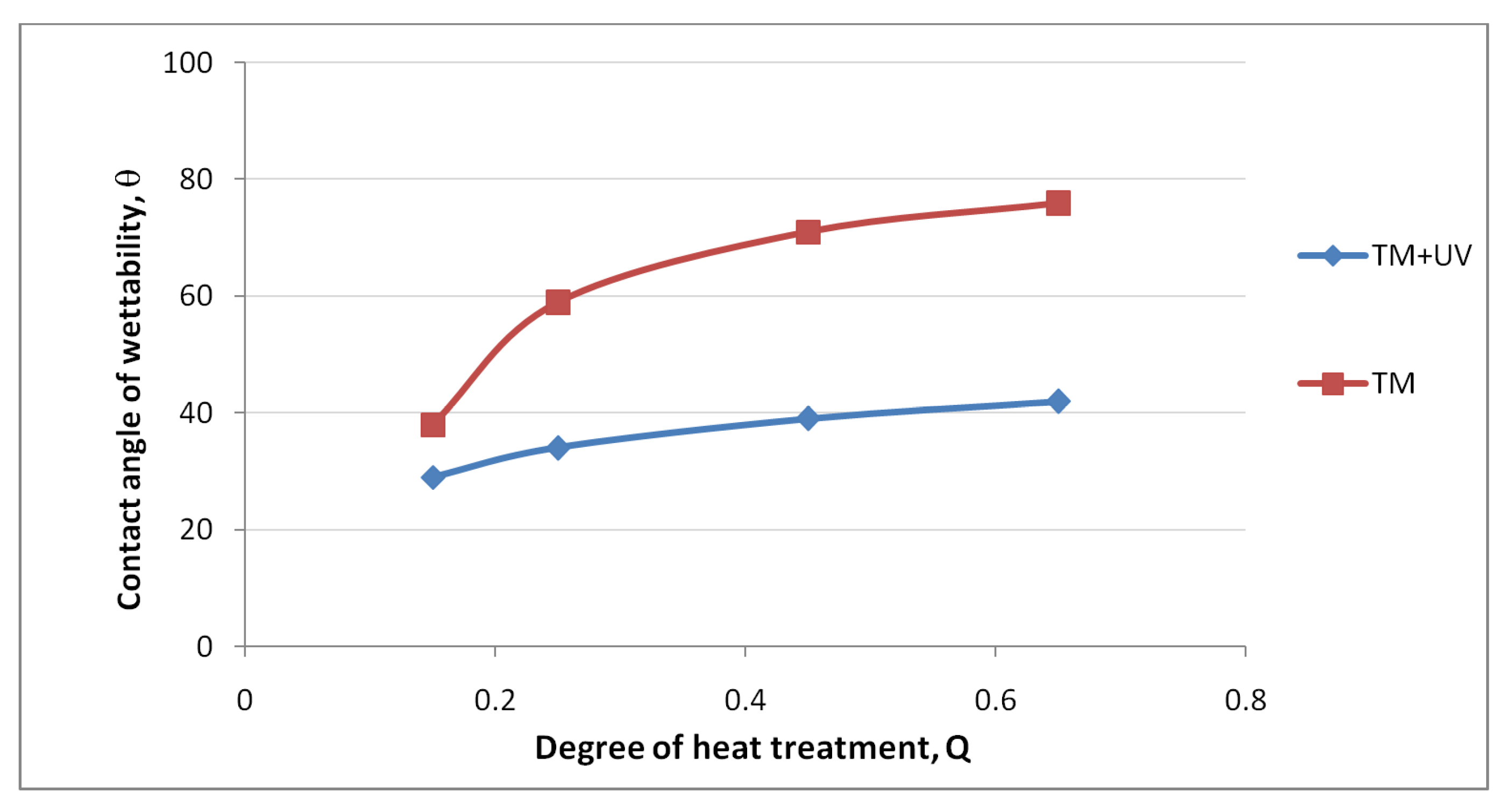1. Introduction
Wood, due to the combination of such unique natural properties as availability, ease of processing and chemical resistance has found wide application in a variety of areas and spheres of human life.
However, wood as a structural material, as well as filler in composite materials, is not without drawbacks, which include significant volumetric moisture deformations, the development of swelling pressure, pronounced anisotropy and water absorption [
1,
2]. At the same time, hygroscopicity and wettability should be attributed to the physical properties of wood, which have a significant effect on the development of the listed disadvantages. Various methods of chemical modification are used to eliminate the existing shortcomings of wood, however, they are not devoid of a negative effect: the strength of the treated wood decreases, the processed material does not adhere well, and its toxicity increases [
3,
4,
5].
In this regard, the methods of physicochemical action on wood raw materials, based on thermal modification of the wood structure, which leads to numerous reactions occurring at different stages of this process without losing the main components (cellulose and lignin) have attracted great interest of researchers in the last two decades [
6]. Heat treatment of wood occurs at temperatures of 160−250 °C without the access of air oxygen, which causes a change in the physical properties and chemical composition of wood [
7]. During heat treatment, irreversible changes occur in the structure at the molecular level, which are a consequence of the decomposition of hemicellulose, a decrease in the level of cellulose and lignin polymerization [
8,
9].
The most active developments in the field of technologies for thermal modification of lumber and equipment are carried out in such leading countries in woodworking as Finland, Germany, Canada, and France [
10,
11,
12,
13], where the distinctive features are in the approaches to the process of thermal modification: in the use of various media to create oxygen-free conditions-the use of water vapor, nitrogen, flue gases, vacuum or various liquids. Saturated water vapor in addition to the targeted physicomechanical properties is often used in the production of plywood, bent furniture, pressed wood, or in case of color changing of wood [
14,
15,
16]. At the same time, all the researchers pursue the same goals: changes in the chemical composition of wood as a result of thermal modification in order to reduce sensitivity to moisture, entailing an increase in bio-stability and dimensional stability.
Researchers consider that an important aspect of the use of preliminary heat treatment of wood filler in the production of composite materials is a decrease in swelling pressure with an increase in processing temperature, as well as a decrease in shrinkage and swelling coefficients in proportion to an increase in the temperature of thermal modification [
17].
The results of studies of thermal characteristics of thermally modified wood (TMW) are presented in the work of Safin et al. [
18]. It has been established that with an increase in the processing temperature, the values of the thermal conductivity and thermal diffusivity of the material significantly decrease, which is explained by the author by a decrease in the density of wood and a change in the chemical composition of wood. This contributes to a change in the cellular structure of the wood. At the same time, the structure of cellulose remains unchanged. In the process of heat treatment, pentoses decompose and the moisture content in the wood decreases, which, in turn, increases the wood′s resistance to decay [
19,
20].
The influence of technological regime parameters of thermal modification of wood on its mechanical characteristics after a year′s exposure in moist soil was revealed in work [
18]. It has been found that the strength indicators of natural wood fall much more intensively than that of thermo modified wood, which leads to the fact that after a year of aging in the soil surpasses natural wood in strength, although initially it was inferior to it in this indicator. The increase in the biostability of TMW was explained not only by chemical changes occurring in wood, but also by the influence of physical factors: a decrease in water absorption with a simultaneous increase in the drying rate of moist TMW in comparison with natural wood leads to a reduction in the residence time of thermal wood in the humidity zone (30−70%), most favorable for wood-destroying fungi [
21,
22].
The results of experimental studies of the energy-power parameters of the process of longitudinal and transverse cutting on a pile driver and surface roughness after shaping on a thickness planer of TMW, depending on the processing temperature are presented in the works [
23]. The authors conclude that the value of the specific work of cutting decreases with an increase in the temperature of thermal modification, which is explained by a decrease in the strength properties of TMW. At the same time, there is a significant increase in surface quality during shaping: there is a decrease in roughness by more than 2 times. Shaikhutdinova et al. [
23] explains this phenomenon by a decrease in the resilient-elastic properties of wood, which, in turn, suggests an increase in the fineness of grinding when grinding thermally modified wood in the production of composite materials. The cutting power when milling heat-treated wood was up to 50% lower than that of untreated wood [
24,
25,
26].
During the operation of products made of heat-treated wood, the important characteristic is the adhesion of paint and varnish coatings to the wood surface, which depends significantly on the ability of the glue to wet the surface. This ability is determined by the value of the contact angle of wetting. It has been experimentally established that an increase in the temperature of impact on wood during its thermal modification leads to an increase in the contact angle θ of the paint and varnish coating from 59° (at 60 °C) to 75° (at 225 °C), what increases the water repellency of wood. However, there are also negative consequences, such as a decrease in strength, hardness, etc. This is due to decomposition of hemicellulose and depolymerization of cellulose. Measurements of the contact angle before and after treatment showed a significant increase in the hydrophobicity of the wood. The wetting angles of the water droplet were in all cases systematically higher for heat-treated wood than for untreated wood [
27,
28].
The inactivated wood surface weakly binds to adhesives due to physical and chemical modifications of the surface, which lead to a decrease in the ability of the adhesive to penetrate deeply and be absorbed into wood [
29]. In addition, some shredded wood fibers may not come into contact with the adhesive due to the high degree of surface energy [
30].
The authors [
31] carried out a study of the adhesive strength of the glue to TMW by the normal peel method using a portable PosiTest
®AT adhesiometer. The research results showed that the adhesion strength of the covering coatings on the samples modified at temperatures up to 180 °C was more than 5 MPa. With an increase in the heat treatment temperature to 200 °C, the adhesion strength of these specimens decreased to 0.8 MPa.
Thus, the technology of heat treatment of wood provides a material with predictable consumer properties, the most important of which are prolongation of the service life, stability of geometric dimensions, rich colors, and high biostability, which leads to the expansion of areas of application of wood products. However, researchers point to a significant decrease in the adhesion of glued compositions to TMW, which complicates the creation of high-strength glued structures.
The work of Khasanshina et al. [
32] is devoted to the problem of increasing the surface wettability of unmodified wood by ultraviolet treatment, due to the exhaustion of the possibilities of modifying materials by traditional methods.
Ultraviolet (UV) radiation accelerates the surface oxidation process, which leads to the adding of a functional (carboxyl) group and contributes to an increase in the wettability and an increase in the free surface energy of wood. Thus, Khasanshina et al. [
32] found that the modification of the surface layer of the material by the action of ultraviolet radiation contributed to an increase in the wettability of wood. An increase in the contact angle was observed with an increase in the power of UV radiation and the processing time: for example, with an ultraviolet irradiation of 62 W/cm
2, the contact angle of pine specimens decreases by an average of 36%; with an irradiation of 375 W/cm
2, the contact angle is no longer more than 35% of the initial value [
32]. It was found that the efficiency of UV treatment was also influenced by the density of wood, since the maximum value of the radial surface wettability for pine specimens was achieved with irradiation of 187 W/cm
2 after 1.5 h of UV treatment, while for beech specimens treatment for at least 2.5 h at irradiation of 311 W/cm
2 was required to achieve maximum wettability. The tangential surfaces of both wood species showed similar results. It was also concluded that UV irradiation for pine samples provided surface cleaning, pore opening, changes in the surface structure, and, to a certain extent, changes in the surface chemical composition. Moreover, the results showed that the extractive content of wood plays an important role in color change not only during heat treatment, but also during light exposure. It was found that compared to thermally untreated samples, heat treatment at 200 °C reduced the red color change due to photodegradation. The change in yellow color during photodegradation was practically not affected by the applied heat treatments, which shows that heat treatments cannot reduce the light decomposition of lignin [
33,
34].
In the study below, we evaluate the possibility of UV exposure to activate thermally modified pine wood to increase surface roughness, enhance wettability of TMW and adhesive strength of the glue in the production of wood block furniture panels.
2. Materials and Methods
The study of the influence of ultraviolet treatment on thermally modified wood was carried out on the samples of Pinus sylvestris, common in the European part of Russia. The choice of pine is due to the fact that it is one of the most widely used softwood species in the industry in Russia.
By its structure, wood is characterized by significant unevenness of density, porosity and a number of other biological factors that affect the process under study. Therefore, in order to obtain the most homogeneous starting wood, careful selection of samples is necessary.
Samples were made from one log 2 m long. For this purpose, the logs were selected without any defects or damage. Logs were cut from a tree trunk at a distance of 2 m from the stump. The heartwoods were discarded when cutting logs. Further, samples of certain sizes were made on a milling machine. In this case, the deviation from the nominal dimensions of the samples did not exceed ±0.5 mm. The linear dimensions of the samples were measured with a micrometer with an error of ±0.01 mm.
As samples for experimental studies of the processes of thermal modification and ultraviolet treatment, wood blocks with a cross section (mm) of 20 × 100, 50 × 50 (the last dimension along the fibers) with thicknesses of 7 and 22 mm and initial moisture content of 6–2% were prepared. The total number of wood samples tested was 120.
Blocks with dimensions with a width of 20 mm and a length of 100 mm were used for testing the strength of the glutinous seam. For this, 48 wood blocks were used, subjected to thermal modification and UV treatment.
Blocks with dimensions with a width of 50 mm and a length of 50 mm were used in research to determine moisture absorption, wettability and adhesive strength of treated wood. The total number of wood samples was 24 pieces for each study.
Preliminary thermal modification of wood materials was carried out by vacuum-contact method in a laboratory setup. The choice of this method for modifying the material is due to the fact that with conductive heat supply, it is possible to achieve high quality heat treatment and precisely achieve the required degree of thermal modification. For thermal modification, absolutely dry wood was used, dried at a temperature of 105 °C to constant weight. The parameters of the wood heat treatment process varied within the following limits: the temperature of the environment during the high-temperature treatment was set in the range of 180−240 °C, depending on the specified degree of treatment, the absolute pressure in the chamber was 20 kPa. In order to ensure the uniformity of heat treatment over the section of wood, the rate of rise of the heating plate to the processing temperature was carried out at a rate of no more than 2 °C/min. Soak at a constant temperature of thermal modification was 45−120 min, depending on the size of the processed material and the degree of heat treatment.
Thermal modification is carried out until a predetermined degree of heat treatment is achieved, determined by the degree of decrease in wood density according to Equation (1).
where:
Q-degree of thermal modification;
-initial density, kg/m
3;
-current density; kg/m
3,
-final density, kg/m
3.
The choice of the density of the material to determine the degree of heat treatment is explained by the fact that this parameter is the most striking indicator, changing in the process of thermal modification. The density of thermally modified wood was measured immediately after heat treatment, which prevented the sample from moistening due to hygroscopicity.
The diagram of a laboratory setup for vacuum-conductive thermal modification of wood material is shown in
Figure 1.
The laboratory setup consists of a heat-insulated sealed chamber 1 with a cover 2. Cover 2 is a frame on which a vacuum membrane is fixed, capable of squeezing the stack 7 under the influence of atmospheric pressure during vacuum processing. Chamber 1 through valve 3 communicates with the vacuum line, which includes pump 4 and condenser 5 with a condensate collector 6. Heating plates 8 are used to supply heat energy to material 7. For the purpose of conditioning wood processing 7, the setup is supplemented with a steam generator 9.
The laboratory setup works as follows. Before the start of the processing process, the material is weighed and placed between the heat-supplying surfaces 8 of the chamber 1. Then the cover 2 is closed, which contributes to the tight fit of the wood with the plates 8, and the material is heated. At the same time, vacuum processing is carried out in chamber 1 by opening valve 3, supplying refrigerant to condenser 5 and turning on vacuum pump 4. At the end of the thermal modification process, the chamber is depressurized by valve 10.
After thermal modification, the samples were subjected to double-sided planing to a thickness of 5 and 20 mm, respectively, in order to remove products of its decomposition from the wood surface. Removal of the surface layer is necessary in order to remove the decomposition products of resinous substances melted onto the surface during heat treatment.
To study the process of ultraviolet processing of wood, an experimental setup was created the diagram of which is shown in
Figure 2. An experimental installation for ultraviolet irradiation of wood consists of a chamber 1 with reflective elements, a UV lamp 2, shelf holders 3, a grate 4, and a process parameter control system 5.
To reflect ultraviolet rays, the inner wall of the chamber 1 has a mirror coating. Ultraviolet lamp 2 is located in the upper part of the chamber 1 above the processed material and is equipped with a protective cover. The lamp and the protective cover form a single element and are installed in the chamber with the possibility of adjusting the radiation power. In order to increase the processing power, the chamber can be supplemented with a second UV lamp. The power supply of the UV lamp 2 is provided by the process parameter control system 5.
The processed material is placed on a grid, which is capable of transmitting electromagnetic radiation from the reflective elements of the chamber to the bottom of the processed material. However, during the experiments, the studies were carried out on a layer of wood facing the radiation source.
A mercury discharge lamp with a quartz glass bulb was used for UV treatment. Wood samples were processed in an ultraviolet radiation source with output parameters: spectral radiation range is 230−400 nm, the duration of processing of raw materials is 30−180 min, and rated power is 30−125 W. Irradiation was carried out when the lamp was located at a distance of 11 cm from the wood surface, the intensity of the incident radiation was 200−400 Nm. The total exposure (W/cm
2) was calculated as the product of the power of the radiation source and the processing time (
Table 1).
To determine the moisture absorption of treated wood samples, a standardized method was used, which was carried out in a desiccator while keeping the samples in a humid environment. The studies were carried out at a constant high relative humidity.
The method for determining moisture absorption of wood materials is as follows. Thermally modified and subjected to subsequent surface UV-treatment pine samples in the form of a rectangular prism with a width of 50 mm and a length of 50 mm are dried to dryness and weighed on an electronic weighing system. After that, distilled water is poured into the desiccator at the bottom. The samples are placed with their lateral surface on special inserts so that they do not touch each other and the walls of the desiccator and closed with a cover. The experiment is carried out at a temperature of 20 °C. Samples are periodically weighed with a drawback of not more than 0.01 g. The first weighing is carried out from the moment the samples are placed in a desiccator, followed by 2, 3, 6, 9, 13, 20 and 30 days.
Investigations of the wettability of pine thermo wood, treated with ultraviolet light, were carried out on a special microscope by the method of a resting “lying” drop, as the most simple and convenient.
Experiments were carried out for samples subjected to thermal modification of various degrees of heat treatment and subsequent UV irradiation. The sample under study was placed on a stage in a strictly horizontal position inside the bell. In the course of the study, a drop of 10% aqueous solution of polyvinylacetate (PVA) was applied to the surface of the wood by squeezing it out of the syringe using a micrometer screw of the CT-12 preparation driver fixed rigidly to the tripod. Moving the syringe rod with a micrometer screw by exactly the same number of divisions allows you to get portions of the PVA solution on the wood surface of the same size in all experiments. The location of the wood sample was made in such a way that its investigated surface was in line with the optical axis of a horizontal microscope equipped with an optical goniometer and an illuminator. The values of the contact angles were measured with an accuracy of ±0.5° every 30 s at a constant temperature. The number of parallel experiments in all cases was at least 5 and the confidence level was 95%.
Cold-setting adhesive based on PVA were used as a binder. The choice of glue is due to the fact that PVA-based glue is the most common in the production of joinery boards, due to the relatively high speed of curing, low cost and high strength of the glue seam.
The determination of the adhesion strength was carried out on wood samples of material with a width of 50 mm and a length of 50 mm and a thickness of 20 mm. The essence of the technique consists in tearing off the element glued to the layer applied to the surface of the wood with the glue solution. Before testing, the samples were preliminarily kept for 5 h in a room at an air temperature of (20 ± 2) °C and a relative humidity of 55−70%. Next, a fluoroplastic sleeve 10 mm in diameter was applied to the sample surface and an adhesive solution was applied. The samples were kept for 24 h at a temperature of 20 °C. As a result, a binder layer 1−2 mm thick was formed on the wood surface. Then a stock with a layer of epoxy resin with a polyethylene polyamine hardener was placed inside the sleeve. To carry out the separation, the sample was centered in a special device (
Figure 3 and
Figure 4). The glues prepared in this way were tested by the pull-off method on a press-type machine.
For testing, a SHIMADZU tensile testing machine was used. The breakaway speed was 0.175 mm/min, and the force was recorded with an optical dynamometer with an accuracy of ±0.05 N. In each case, the number of parallel experiments was at least 10 with a confidence interval of 95%. In this case, only the results of adhesive detachment were taken into account, although in some cases both mixed and cohesive detachment along the substrate was observed [
35]. Adhesion tests were carried out on the samples in dry form and after boiling for 3 h.
Adhesive detachment strength for each sample was determined with an accuracy of 0.1 MPa using the following Equation (2):
where
A—adhesive strength, MPa;
P—is the value of the breaking load, N;
d—cylinder inner diameter, mm;
Sdet—area of detachment, mm
2.
Shear strength tests were also carried out on a universal tensile testing machine. The ultimate shearing strength of an adhesive overlap joint was determined by creating a shear action on the overlap joint between the parts to be glued as a result of applying to these parts a tensile force parallel to the plane of joining the parts and the longitudinal axis of the test specimen. The bonding characteristics of the samples were evaluated by their tensile strength.
The samples were prepared as follows: wood blocks without blemishes with a length of 100 mm and a width of 50 mm and a thickness of 20 mm, subjected to two-stage preliminary processing (thermal modification + UV treatment), were glued over a wide area with an adhesive consumption of 130 g/m
2. The scheme of bonding and testing of samples is shown in
Figure 5. The glued samples were stored at a temperature of 18−22 °C for 10 days until the glue was completely cured. Then, one part of glued samples was boiled (boiling time-3 h), and the other was examined in dry form.
Statistical processing of the research results was carried out using the Software Statistica 8.0 package. The data obtained are presented as an average value and a confidence interval. The relative error of the research results was determined by the standard deviation and Student′s criterion (tc = 3.2) for a confidence level of 0.95 and a sample group equal to 4.
3. Results and Discussion
A preliminary analysis of the required power of UV irradiation was carried out to change the properties of the surface of thermo wood by studying the change in the contact angle of wetting of pine thermo wood with water. The results are shown in
Figure 6.
The conducted studies of the influence of the power of ultraviolet treatment on the contact angle of wood wetting showed that the process of surface inactivation proceeds most actively during the first 60 min, at which the total UV radiation reaches 125 W/cm2. In this case, taking into account the measurement errors with a probability of 0.95, it follows that a further increase in the processing time does not give a significant effect. At the same time, taking into account the relative measurement error of 12.4% with a confidence interval of 0.95, a further increase in the processing time does not give a significant effect. As a result, further studies of the effect of UV treatment on the properties of thermal wood were carried out on samples subjected to total UV irradiation at a rate of 125 W/cm2.
The results of a study of the effect of UV radiation on the hygroscopicity of samples with different degrees of heat treatment are presented in
Figure 7. In this case, graphs of the dependence of the change in the relative mass of wood samples on the soaking time in a humid environment are presented.
Analysis of the graphs shows that UV treatment of thermally modified pine samples causes a slight increase in the hygroscopicity of the material. This is due to the fact that as a result of ultraviolet treatment of the lignocellulosic material, surface changes occur: the surface becomes loose, as a result of which liquid vapors actively penetrate into the surface layers of the material. The results obtained are consistent with the studies of Kubovský et al. [
33], where the wood wettability also increases due to UV treatment. At the same time, the inner layers of the material, due to the high-temperature processing of wood contribute to an integral decrease in the hygroscopicity of the material in proportion to the degree of heat treatment.
As a result of the study of the wettability of pine thermo wood treated with ultraviolet light by the method of “lying” drop, it was found that UV irradiation of thermally modified wood increased its wettability. Rapid spreading of the drop over the surface of the thermally modified sample treated with UV is noted. A drop of water applied to the surface of the sample completely spread over the surface of the material by the 90th second, covering it with a thin layer. In the case of the control sample, the drop remained in the formed form on the surface for at least 10 min.
In addition, the influence of the degree of thermal modification on the change in the contact angle of wetting of pine wood was revealed (
Figure 8): as can be seen from the graph, with an increase in the degree of heat treatment, a significant increase in the studied parameter is observed. The average value of the contact angle for thermally modified samples is
x = 61 for which, with Student’s criterion
tc = 2.1 and a confidence interval α = 0.95, the relative error is ε = 22.19%. For samples that have undergone two-stage processing, the values are
x = 36, ε = 16.67%. Thus, UV treatment can reduce the contact angle by 41%. The presented effect of heat treatment is consistent with the following research [
18,
19,
20,
23].
In this case, the UV treatment of the material surface with a power of 125 W/cm2 practically neutralizes the effect of high-temperature exposure and does not significantly depend on the degree of preliminary heat treatment.
Experimental studies to determine the adhesive strength of the binder to the surface showed the following results (
Table 2).
From the given data it can be seen that thermo modification reduces the adhesion of the binder to the wood surface, which is explained by the deterioration of the wettability of thermal wood. The results obtained are also confirmed in works [
18,
19,
20,
23]. At the same time, it follows with a probability of 0.95 that the strength of the glue seam when gluing natural wood samples after boiling decreased by 46%, thermally modified samples-by 26%, and samples that underwent two-stage processing-by 22%, which means that the decrease is more than two times in relation to natural unprocessed samples. The relative research error is 5.2%.
At the same time, ultraviolet irradiation contributes to an increase in the adhesive interaction of the binder with the surface: wherein the combined action of two-stage wood treatment, including preliminary thermal modification followed by surface UV treatment, causes persistent adhesion of the binder to wood even after boiling compared to the use of natural wood. It can be used to improve the technology for the production of furniture boards, characterized by increased moisture and water resistance. At the same time, taking into account the measurement errors with a probability of 0.95, we can assume that UV treatment contributes to an increase in the adhesion properties of the surface of thermally modified wood by more than 13%. The relative error of the studies is 3.6%.
The results of studying the ultimate shear strength of the samples are shown in
Figure 9.
The results of the study of the shear strength of the glued joint repeated the results of the previous experiment, confirming the effectiveness of two-stage wood processing when creating glued products.
